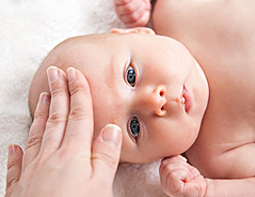Fever in children
What is a fever?
A fever is a rise in the body’s temperature above normal. A ‘normal’ temperature in babies and children is about 36.4°C, but it can vary depending on how it is measured and also at different times of the day.
A fever is a natural response designed to help fight off infections caused by bacteria or viruses. The infection causes the immune system to reset the body’s thermostat to a higher level to help ‘fight off’ the bug.
A temperature of 38°C or above usually means they have a fever. However, a high fever doesn’t necessarily mean your child has a serious illness.

What is a normal temperature?
A normal temperature is when your child’s body temperature is around 36.4°C. Remember that a child’s normal body temperature can vary depending on where it is measured, and also at different times of the day.
Always see your doctor if your baby is under 3 months old and has a temperature above 38°C – even if they have no other symptoms.
How to take your child’s temperature
It’s a good idea to check your child’s temperature if their skin feels hot or they seem unwell.
Here are three ways to take a child’s temperature – but remember it’s important to carefully read the instructions that come with your thermometer before using it for the first time:
1. Under the arm (axilla)
- Place the thermometer in the child’s armpit
- Hold their arm against their body
- Remove the thermometer and read the temperature after the manufacturer’s recommended amount of time.
2. Under the tongue (oral) – recommended for children over 4 years old
- Not recommended if your child has recently had a hot or cold drink
- Place the thermometer well under one side of your child’s tongue and have them hold it in place with their lips (not their teeth)
- Remove the thermometer and read the temperature after the manufacturer’s recommended amount of time.
3. In the ear (tympanic) – recommended for children over 6 months
- Always follow the manufacturer’s instructions on how to use your thermometer
- Slide a new throw-away cover over the tip of the thermometer
- Gently pull the child’s ear back
- The thermometer tip should be gently placed in the ear canal so that it fits snugly
- After taking the reading remove the thermometer and dispose of the cover.
Safety tips
- Carefully read and follow the manufacturer’s instructions
- Clean the tip of the thermometer (following the manufacturer’s instructions) before and after each use
- Never leave your child alone while you’re taking their temperature.
If you’re unsure how to best use your thermometer, ask your pharmacist to show you how.
When should I take my child to see the doctor?
Always take your child to the doctor if they are under three 3 months old and their temperature is above 38°C – even if they have no other symptoms.
For children older than 3 months – see a doctor if your child has a temperature is above 38°C and any of the following symptoms:
- They have a stiff neck or eyes are sensitive to light
- They are vomiting and refusing to drink
- Have a rash
- Are sleepier than normal
- Have any problems with their breathing
- Any pain does not improve after taking pain relief medication.
It’s also important to take your child to your doctor if they:
- Have had a fever (with no obvious cause) for more than 2 days
- Appear to be getting more unwell
If you have any concerns about your child’s health, consult your healthcare professional.
How can I help if my child has a fever?
- Let them rest
- Dress them lightly but ensure they are not cold
- Give plenty of fluids to drink. If your child is younger than 6 months, give extra breastfeeds, cooled boiled water or bottles of formula
- Wipe or sponge you child with tepid water – but avoid cold baths or showers
- Give paracetamol – such as Dymadon – can provide gentle temporary relief of your child’s pain and fever. Always follow the dosing instructions on the packaging and do not give more than the recommend number of doses in a day
Ask for Dymadon paracetamol at your pharmacy.
